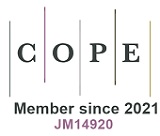CLSI Guided Reference Interval Limits for Cancer Biomarkers for Adults and Geriatrics
Downloads
Doi:10.28991/SciMedJ-2022-04-02-04
Full Text:PDF
Downloads
EP28-A3C. (2008). Defining, Establishing, and Verifying Reference Intervals in the Clinical Laboratory; Approved Guideline (3rd Ed.). Clinical and Laboratory Standards Institute, Wayne, United States.
Chen, F., Shen, J., Wang, J., Cai, P., & Huang, Y. (2018). Clinical analysis of four serum tumor markers in 458 patients with ovarian tumors: diagnostic value of the combined use of HE4, CA125, CA19-9, and CEA in ovarian tumors. Cancer Management and Research, 10, 1313. doi:10.2147/CMAR.S155693.
Vestergaard, E. M., Hein, H. O., Meyer, H., Grunnet, N., Jørgensen, J., Wolf, H., & Ørntoft, T. F. (1999). Reference values and biological variation for tumor marker CA 19-9 in serum for different Lewis and secretor genotypes and evaluation of secretor and Lewis genotyping in a Caucasian population. Clinical Chemistry, 45(1), 54–61.
Bjerner, J., Høgetveit, A., Wold Akselberg, K., Vangsnes, K., Paus, E., Bjøro, T., Børmer, O. P., & Nustad, K. (2008). Reference intervals for carcinoembryonic antigen (CEA), CA125, MUC1, Alfa‐foeto‐protein (AFP), neuron‐specific enolase (NSE) and CA19.9 from the NORIP study. Scandinavian Journal of Clinical and Laboratory Investigation, 68(8), 703–713. doi:10.1080/00365510802126836.
Qin, X., Lin, L., Mo, Z., Lv, H., Gao, Y., Tan, A., Yang, X., Li, S., & Zhao, J. (2011). Reference Intervals for Serum Alpha-Fetoprotein and Carcinoembryonic Antigen in Chinese Han Ethnic Males from the Fangchenggang Area Male Health and Examination Survey. The International Journal of Biological Markers, 26(1), 65–71. doi:10.5301/jbm.2011.6364.
Zhang, G. M., Guo, X. X., Ma, X. B., & Zhang, G. M. (2016). Reference intervals of alpha-fetoprotein and carcinoembryonic antigen in the apparently healthy population. Medical Science Monitor, 22, 4875–4880. doi:10.12659/MSM.901861.
Cho, J. S., Kim, C. I., Do Hwan Seong, H. S. K., Kim, Y. S., Kim, S. J., Cho, I. R., ... & Chung, B. H.. (2005). Relationship between serum prostate-specific antigen and prostate volume in men with benign prostatic hyperplasia from multicenter study. Korean journal of urology, 46(8), 792-798.
Luboldt, H.-J., Schindler, J. F., & Rübben, H. (2007). Age-Specific Reference Ranges for Prostate-Specific Antigen as a Marker for Prostate Cancer. EAU-EBU Update Series, 5(1), 38–48. doi:10.1016/j.eeus.2006.10.003.
Khezri, A. A., Shirazi, M., Ayatollahi, S. M. T., Lotfi, M., Askarian, M., Ariafar, A., & Afrasiabi, M. A. (2009). Age specific reference levels of serum prostate-specific antigen, prostate volume and prostate specific antigen density in healthy Iranian men. Iranian Journal of Immunology, 6(1), 40–48.
Park, Y., Kim, Y., Lee, E. Y., Lee, J. H., & Kim, H. S. (2012). Reference ranges for HE4 and CA125 in a large Asian population by automated assays and diagnostic performances for ovarian cancer. International Journal of Cancer, 130(5), 1136–1144. doi:10.1002/ijc.26129.
Liu, X., Wang, J., Zhang, S. X., & Lin, Q. (2013). Reference ranges of age-related prostate-specific antigen in men without cancer from Beijing area. Iranian Journal of Public Health, 42(11), 1216–1222.
Rahman, M. T., Sajani, T. T., Sultana, R., Choudhury, S. R., & Siddiqui, M. M. R. (2014). Prostate Specific Antigen (PSA): Normal Reference Value in Bangladeshi Male, a Retrospective PSA Analysis of 765 Male. Anwer Khan Modern Medical College Journal, 5(1), 19–22. doi:10.3329/akmmcj.v5i1.18766.
Slev, P. R., Rawlins, M. L., & Roberts, W. L. (2006). Performance Characteristics of Seven Automated CA 15-3 Assays. American Journal of Clinical Pathology, 125(5), 752–757. doi:10.1309/g6x6pr7526fakv0e.
Hayes, D. F., Zurawski, V. R., & Kufe, D. W. (1986). Comparison of circulating CA15-3 and carcinoembryonic antigen levels in patients with breast cancer. Journal of Clinical Oncology, 4(10), 1542–1550. doi:10.1200/JCO.1986.4.10.1542.
Duffy, M. J. (1999). CA 15-3 and related mucins as circulating markers in breast cancer. Annals of Clinical Biochemistry, 36(5), 579–586. doi:10.1177/000456329903600503.
Rubin, J. B., Lagas, J. S., Broestl, L., Sponagel, J., Rockwell, N., Rhee, G., Rosen, S. F., Chen, S., Klein, R. S., Imoukhuede, P., & Luo, J. (2020). Sex differences in cancer mechanisms. Biology of Sex Differences, 11(1). doi:10.1186/s13293-020-00291-x.
Zhang, G. M., Bai, S. M., Zhang, G. M., & Ma, X. B. (2018). Reference intervals of carbohydrate antigen 19-9 in the apparently healthy adult population. Journal of Clinical Laboratory Analysis, 32(5). doi:10.1002/jcla.22380.
La’ulu, S. L., & Roberts, W. L. (2007). Performance characteristics of five automated CA 19-9 assays. American Journal of Clinical Pathology, 127(3), 436–440. doi:10.1309/H52VET3M6P7GYWG1.
Pauler, D. K., Menon, U., McIntosh, M., Symecko, H. L., Skates, S. J., & Jacobs, I. J. (2001). Factors influencing serum ca125ii levels in healthy postmenopausal women. Cancer Epidemiology Biomarkers and Prevention, 10(5), 489–493.
- This work (including HTML and PDF Files) is licensed under a Creative Commons Attribution 4.0 International License.












